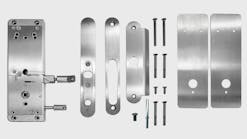In most buildings, the security goals are fairly straightforward - keep unauthorized individuals out while allowing free egress for occupants. However, healthcare facilities present a number of challenges that make it particularly difficult to maintain the delicate balance between life safety and security. Because of the wide-ranging security needs of patients, unauthorized access and egress must be restricted while still maintaining an open and welcoming atmosphere. Some patients require free egress, while others need to be contained for their own safety. Countless visitors and staff require varying degrees of access to the facility, but must also be effectively deterred from stealing any of the supplies, equipment or controlled substances located within. Add to that a whole host of stringent regulations and building codes that must be complied with, and it’s clear why the requirements for any healthcare facility’s access control solution are incredibly complex.
This article will be focusing on controlled egress locks and the many roles they can play within these facilities to prevent patient abduction and elopement, and enhance security without jeopardizing life safety.
Delayed vs. Controlled Egress
For many years, healthcare facilities installed delayed egress locks in areas such as memory care, maternity, pediatric and emergency care units where unauthorized egress could present risks to patient safety. However, these locks that allow egress after a 15-second delay were not always sufficient to deter patients or visitors from using the doors. This puts the patients at risk of elopement or, in the case of infants and children, possible abduction.
With the addition of a new section in the 2009 International Building Code (IBC), healthcare facilities are now permitted to restrict free egress on exit doors using controlled egress locks. If installed and maintained appropriately, these locks can be an effective way of enhancing patient security in high risk areas without jeopardizing life safety. In the 2015 edition of the IBC, this is covered by section 1010.1.9.6 - Controlled egress doors in Groups I-1 and I-2.
Delayed and controlled egress are frequently confused, largely because the section added to the 2009 edition of the International Building Code (1008.1.9.6 - Special Locking Arrangements in Group I-2) used the term “delayed egress lock” to describe a fail-safe lock that would only be released in an emergency to allow egress. Once the mistake was recognized, the term was changed in the 2012 edition to “special egress lock” and then changed yet again in the 2015 edition to “controlled egress lock.”
This most recent change will hopefully be the IBC’s final word on the subject, but there is a great deal of residual confusion regarding the use of delayed egress vs. controlled egress. It is vital that those specifying and installing hardware within these facilities understand the difference. Delayed egress locks must automatically unlock 15 seconds after a building occupant actuates the device (or up to 30 seconds with Authority Having Jurisdiction (AHJ) approval). Controlled egress locks allow the egress doors to remain locked until they are unlocked by staff. Depending on the occupancy type and specific application, they may also be unlocked by the automatic fire protection system or a power failure.
Applications
It is in healthcare facilities that we find most of the rare circumstances where restricting egress can actually save lives. The maternity ward contains some of the most helpless patients and many hospitals have begun using controlled egress locks to protect them. Although infant abductions are typically perpetrated by strangers, it is not uncommon for abductions to be committed by family members or even hospital staff. As a means of preventing this rare but serious risk, an RFID tag is embedded in the wrist or ankle bracelet placed on all newborns and the infant abduction system will sound an alarm and lock the exit doors when it detects one approaching. By incorporating controlled egress locks into this system, it becomes possible to prevent the abductor’s escape, and alert trained staff and security team members to respond.
Sometimes, however, it’s not criminals whose egress needs to be prevented but rather the patients themselves. In the past, patients with mental illness were primarily treated at specialty facilities that were prepared to handle their needs. Unfortunately, state funding of these facilities has dramatically declined over the years. With passage of the Affordable Care Act, a growing number of patients are now being diagnosed and, with few alternatives available, they are being treated in emergency rooms and hospitals that are often ill-equipped to protect them from harming themselves or others.
When patients with serious mental illness elope, they are more likely to engage in suicidal and homicidal behavior. As a result, the focus must be on not only protecting the patient, but also the people in the immediate areas who might be at risk if a patient flees from their designated area. The use of controlled egress locks as well as other specialty hardware like ligature resistant locks can give patients more freedom while protecting them from elopement and self-harm in behavioral health departments or other areas such as the emergency room.
Unlike delayed egress locks, when the controlled egress device is actuated, it remains secure and can be customized to send a signal to designated parties, giving staff and security guards the opportunity to respond quickly if a patient attempts to leave. However, training staff on emergency evacuation is critical because in some types of facilities, the device is not required by code to automatically unlock and allow egress in the event of a fire alarm or loss of power.
Another common application for controlled egress locks is in long term or memory care facilities. As the percentage of the population over the age of 65 steadily increases, it is estimated that approximately 50 percent will develop dementia or Alzheimer’s. Facilities of this kind are experiencing a shortage of staff to manage this growing population, but studies have shown that 11-24 percent of institutionalized dementia patients will wander if left unmonitored. (Source: http://www.nccdp.org/wandering.htm).
While memory care patients usually don’t typically intend to cause harm to others, they pose an extremely high risk to themselves. Fortunately, there are many solutions available - from real time location service systems (RTLS) that track residents’ movements, to sophisticated medical alert and health monitoring systems - that can provide residents with both greater independence and security. Controlled egress locks can be utilized in conjunction with patient wandering systems to restrict a resident’s attempt to elope by sending an alert to the nurse call system while the door remains locked, preventing egress. These solutions allow healthcare facilities to not only protect their patients, but also themselves as in addition to civil liability, care providers can be fined by the state regulatory agency for failure to prevent elopement.
Code Requirements
The IBC does not specifically state which types of health care units can be equipped with controlled egress locks, but the 2015 IBC Commentary states, “The areas where controlled egress may be permitted include psychiatric areas, dementia units, Alzheimer’s units, maternity units, and newborn nurseries. Code officials may also permit these provisions in other areas such as emergency departments or pediatric areas where the safety and/or security of the occupants are of primary concern.” This helps to establish the intent of section 1010.1.9.6, but the Authority Having Jurisdiction (AHJ) may provide additional guidance.
The IBC requires controlled egress locks in health care facilities to meet the following criteria:
- Door may be equipped with an electromechanical or electromagnetic locking system.
- Controlled egress is allowed for Group I-1 or I-2 facilities where the clinical needs of the patients require their containment.
- The building must be equipped throughout with an automatic sprinkler system or automatic smoke or heat detection system.
- Locks must unlock upon actuation of the sprinkler/fire detection system.*
- Locks must unlock upon loss of power controlling the lock.*
- Locks must have the capability of being remotely unlocked from an approved location (this switch must directly break power to the lock).*
- Building occupants must not be required to pass through more than one door with a controlled egress lock before entering an exit.*
- Procedures for unlocking the doors must be part of the facility’s emergency plan.
- All clinical staff must have the means to unlock the doors, including any required keys, codes, or other credentials.
- Emergency lighting must be present at the controlled egress door.
- The system must be listed in accordance with UL 294 – Standard for Access Control System Units.
* Note: These requirements for automatic/remote release are not required by the IBC for psychiatric treatment areas where patients’ clinical needs require restraint or containment, or for nursery and obstetric areas of hospitals where listed infant abduction systems are in use.
Beginning with the 2009 edition, NFPA 101 includes similar controlled egress requirements in Chapter 18 – New Health Care Occupancies, and Chapter 19 – Existing Health Care Occupancies. It’s important to determine not only which code applies, but also which version of the code has been adopted in the area where the facility is located.
Because the goal of controlled egress locks is to inhibit egress, the codes surrounding their use are understandably complex and restrictive. As a result, mistakes are not uncommon and are often cited by The Joint Commission. What follows are merely a few issues to be aware of when implementing these solutions.
- Which code applies to your use group and occupancy? The IBC and NFPA 101 include criteria for which types of occupancies may be equipped with these devices, and restrictions specific to certain occupancy types. There may also be state or local code modifications that affect these locking arrangements.
- How do these locks integrate with other components of the system? In order to balance life safety with security, most controlled egress locks must release automatically upon activation of the fire alarm system, sprinkler system, a remote signal, and loss of power. These wiring requirements should be coordinated prior to installation.
- Is the product UL Listed? The requirement for electrical components to be listed UL 294 is fairly new to the model codes. Be aware that not all products have been certified to this standard.
- How many egress devices will be installed? For most facilities, there is a limit of one delayed egress lock or controlled egress lock per egress path, but there are some exceptions depending on the occupancy type.
Because of the obvious risks involved, it’s vital to understand the limitations and restrictions before installing controlled egress devices. Thorough training programs must be conducted at regular intervals to ensure all staff are adequately prepared to respond in the event of an emergency.
In a facility where lives are dependent on the balance between containment and egress, it is particularly important that every door and every piece of hardware be compliant with all the relevant codes. If the requirements are carefully followed and the appropriate system is installed as allowed by the code adopted in the project’s jurisdiction, patient security will be enhanced without jeopardizing life safety.
Lori Greene, is the Manager of Codes & Resources for Allegion. For more information about this topic and to download a free reference guide on codes, visit iDigHardware.com/guide.

Lori Greene, DAHC/CDC, CCPR, FDAI, FDHI
Lori Greene, DAHC/CDC, CCPR, FDAI, FDHI, is manager, codes and resources at Allegion. Visit her website, idighardware.com.






